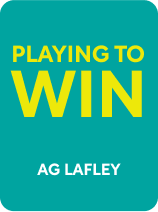

This article is an excerpt from the Shortform book guide to "Playing To Win" by AG Lafley. Shortform has the world's best summaries and analyses of books you should be reading.
Like this article? Sign up for a free trial here .
What is the book Playing to Win: How Strategy Really Works about? How does the cascade strategy framework help companies?
Playing to Win: How Strategy Really Works explores the cascade strategy used by the authors A.G. Lafley (former CEO of P&G) and Roger Martin (former P&G strategic advisor) to double the revenues and profits of Procter and Gamble (P&G) from 2000 to 2009. The cascade strategy helps companies identify their winning aspirations and helps them develop the capabilities and strategies they need to win in the marketplace.
Read more about the lessons in business strategy explored in Playing to Win: How Strategy Really Works.
The Cascade Strategy
In Playing to Win: How Strategy Really Works, authors A.G. Lafley and Roger Martin outline the cascade strategy: an action plan for success in business that they developed while working together as the CEO of and a consultant at Proctor and Gamble (P&G) between 2000 and 2009.
The cascade strategy answers five questions:
- What is your company’s purpose, or “winning aspiration”?
- What are your target markets?
- How do you succeed in those markets?
- What capabilities does your company need in order to “win”?
- How should you manage your company in order to “win”?
Each question tumbles down towards the next, while also helping to refine the answers to the previous questions.
In larger companies, there are many individual choices and larger cascades that function at once and in conversation with one another. For example, a specific brand strategy may connect with a larger sector strategy, which may connect with a company-wide strategy. Each cascade locks together to form a larger group of cascades that determine the overall success of the company.
All employees, from the CEO to a retail salesperson, have to make strategic choices. Consider how a retail employee makes cascade choices:
- The retail employee decides she wants to have the best numbers in her region (the answer to question 1, her “winning aspiration”).
- She recognizes what a needy customer looks like and finds customers she wants to speak to (the answer to question 2, the target market).
- She develops different approaches or ways of talking to different kinds of people—she learns sales strategies, such as being direct and then backing off and allowing the customer to choose (the answer to question 3, her success strategy).
- She creates her own strategies for success, including the tone she uses to talk to potential customers (the answer to question 4, the necessary capabilities).
- She creates systems, like various scripts or guides, that can help her customers (the answer to question 5, the necessary management systems).
Clearly, these choices are different from the more obvious “strategic choices” of a CEO. However, they are choices nonetheless. This retail employee is playing to win. This is an essential part of the cascade strategy explored in the Playing to Win: How Strategy Really Works book. You should make every choice with the express purpose of not just competing, but winning. Winning will look different for different segments of the company—on the company level, it may include becoming the number one player in the market; on an individual level, it may mean having the best sales numbers in a region.
Playing to Win: How Strategy Really Works outlines how companies can win at each level along the cascade. It also explores how to develop a system of decision-making that increases a company’s chances of finding the best solutions.
Question 1: What Are Your “Winning Aspirations”?
To answer the first question in the cascade, figure out your definition of success and what you want your company to achieve. What is the ideal future for your enterprise? The answer, your “winning aspiration,” can include a statement of purpose, but it’s not only a statement of purpose. It’s also a statement of what success—or “winning”—would look like at your company. According to Playing to Win: How Strategy Really Works, once a company understands its winning aspiration, it can take actions to achieve it.
For example, at P&G skincare brand Olay, the winning aspiration was leading the market in the U.S. and being among the worldwide leaders in the skincare industry. The leadership at P&G wanted to create a product that would move Olay into the beauty game and create something with prestige and mass appeal.
To develop your organization’s winning conditions, make your goals about serving and pleasing your customers, not about making a certain amount of money and satisfying your stakeholders. Without customers, you have no chance at success. For instance, famous mission statements like Nike’s (“to bring inspiration and innovation to every athlete in the world”) talk about pleasing customers, not stakeholders. In fact, they talk about victory for their customers—becoming the best or the leader in delivering a service. Research your customers’ needs, then tailor your company to meet that need better than anyone else.
Remember that setting winning aspirations is not the same as achieving them. Without more strategy (covered in the next sections), you’ll have aspirations, but no way to reach them.
Question 2: What Are Your Target Markets?
The second question is one of the most critical in building a winning strategy. It asks on what battlefields a company will fight—in other words, what audience it wants to target. This can include fighting for particular customers, in specific markets, or on particular websites, TV networks, or magazines that appeal to certain demographics.
Be specific about your demographic choices—trying to be different things to different people is a recipe for disaster: It’s difficult to compete for the attention of a young American man and an aging French woman at the same time. Decide which age groups, geographies, or channels (mass merchandise vs. luxury, for example), you want to cater to, based on your company’s capabilities—Olay decided to sell in drugstores because their brand already had a foothold there. Figure out where you have a competitive advantage and direct your resources there.
Consider how a business owner who wants to sell apples would approach the following choices:
- Geography: Where are you competing?
- Should the apple seller buy an orchard locally or in the next town over?
- Product: What are you offering your consumer?
- Should she plant new trees to diversify her selection? Should she make apple pies to sell as well?
- Consumers: Who are you targeting?
- Should she start by selling to just family and friends or try to find a distribution deal?
- Distribution: What strategy will you use to deliver to your consumers?
- Should she open up her orchard for picking or just sell apples wholesale to grocery stores?
- Production: How much of the production of your product will you be responsible for?
- Should she hire workers to help with the picking and packaging? How many?
Small businesses, like this apple grower, have fewer questions than larger ones—for example, larger businesses might also have questions about which distribution companies are best in different parts of the country, or about whether to take business international.
Finally, consider against whom you’re competing. Some competitors have a stranglehold over certain markets and are really good at what they do. Playing to Win: How Strategy Really Works suggests that success against entrenched industry players in a developed market would be much more difficult than in an underdeveloped niche with fewer good competitors, no matter how good the rest of your decision-making is. However, if a company can bring unique value to a market that’s already crowded, they can rise to the top. Just remember that the goal is not just to compete but to win.
Question 3: How Do You Succeed in Those Markets?
Once you’ve picked your playing field, figure out what winning requires in the specific market you’ve chosen. Different companies will have different built-in strengths that will contribute to their ability to win. For instance, small companies can provide a more boutique service while larger companies can deliver quality products at a great price point. Olay realized that its strength was understanding who its best, or “core,” customers were. It built success by continuing to serve them while expanding into new markets and offering new products.
Playing to Win: How Strategy Really Works discusses two ways to find victory in your chosen market—cost leadership and differentiation.
Cost Leadership
In this approach, you win by selling a similar quality product at a cheaper price point than your competitors. If three companies have products that are essentially the same, customers will buy the cheapest of the products. And if companies can cut production costs, they’ll have more flexibility on where to set their price point.
The company that makes the product in the cheapest manner can do a lot more than just undercut the prices of their competitors. Take the example of Mars vs. Hershey: Mars candy is much cheaper to produce, so they can set their prices much lower. Instead of just making their candy cheaper, though, they use their extra money to buy prime racks at grocery stores around the country, so that people run into their product more.
Differentiation
The alternative to having a better cost structure is having a product that consumers want more because it’s of clearly better quality or has clearly better branding and prestige. If it costs two companies the same amount of money to make a similar product, but one company makes a product that consumers like more, consumers will be willing to pay more. This, once again, leads to higher margins that companies can then use to increase their advantage, through avenues such as higher-priced marketing campaigns or buying better racks at the grocery store.
Selling a quality product can also help to develop loyalty, which makes a company less subject to the whims of the market. Loyal consumers believe that a company can add value to their lives and won’t shop around as much.
With a competitive advantage in the market, companies can invest more money into research, marketing, management, or their lower-level employees.
Question 4: What Capabilities Do You Need to Succeed?
Capabilities are the resources and competencies required to find your market and succeed in it. Playing to Win: How Strategy Really Works identifies five capabilities that are essential to success:
- Knowing and understanding the customer: You need to know what the prospective customer needs—more so than your competitors do.
- Innovating: Successful companies change in response to their deep understanding of the customer. Don’t rest on your laurels—improve your products even if things are going well.
- Creating a strong brand: You need a marketing strategy that will help customers easily recognize who you are and build their trust in you.
- Being able to maneuver, or “go-to-market,” quickly: This is the ability to get your innovations in the hands of customers quickly by building good relationships along your distribution line.
- Scaling up: In order to scale successfully—leading to better margins—you need to understand the global market.
Olay realized it needed to innovate an entirely new product in order to compete to win. So P&G (again, Olay’s parent company) brought in scientists, marketing professionals, distribution experts, influencers, and others to create, brand, and market their new product. This required creating capabilities that did not exist before and improving on ones that did.
Question 5: How Should You Manage Your Company?
The final step of the cascade is introducing effective management systems. You need managers who can successfully implement and monitor your overall strategy and help you make important decisions along the rest of the cascade. The mantra among your management team and employees should be: Discuss issues and review strategy in the open, to see if the strategy is working and to continue to innovate based on new challenges.
The Playing to Win: How Strategy Really Works book suggests that the best way to do this is to have regular open strategic discussions. Focus on simple strategic questions and don’t expect to come up with an entirely new strategy in one fell swoop—this can be a continuous process of innovation, discovery, and review of existing systems.
Likewise, train employees to be able to deliver results in line with your aspirations. This includes having a Human Resources department that’s strong and can provide opportunities for advancement. This will keep people happy so that there is little turnover, and thus little need to re-teach your system.
Assertive Inquiry
Playing to Win: How Strategy Really Works suggests moving towards a system called assertive inquiry that aids in the process of having open strategic discussions. This combines the process of advocacy (speaking up for your own ideas with data to back yourself up) with an inquiry into the reasoning of everyone else.
Not only does assertive inquiry sharpen your critical reasoning skills and make others look into the data and motivation behind their own ideas, but it also helps you be more open to change. If a group asks good questions, individuals in that group will be more likely to change their minds about their own ideas. They’ll also be more likely to ask these kinds of questions of themselves.
Be confident in yourself, but also know that you could have missed something that someone else can clarify or tease out. You’re both advocating and listening during the inquiry process.
There are some simple steps you can implement to make assertive inquiry work:
- Present your argument and ask for comments or questions.
- Example: “To appeal to this market, I think we should use Approach A. What are the pros and cons of this approach, and what are alternative approaches?”
- Paraphrase the comments and questions of the questioner.
- Example: “It seems you believe that Approach A won’t work because of Problem Y. Is that accurate?”
- If you don’t understand, ask clarifying questions..
- Example: “Could you tell me more about why Problem Y would hinder Approach A?”
Creating strategy is the work of a group, not an individual. High-achieving individuals will inevitably have different ideas about how to succeed in a sustainable way and what strategies are going to get a company there. Differences aren’t always productive or easy to resolve, but these methods can help.
Cascade Case Study: Proctor and Gamble
In the 1990s, P&G was struggling to sustain success in the skincare market—a sector that can be very profitable and create a lot of loyalty amongst customers. They commonly referred to P&G’s brand “Oil of Olay” as “oil of old lady”—it was boring and old. It was sold primarily at drugstores and was cheap, but as more skincare products came along, it was increasingly less successful.
P&G executives discussed their options:
- Launch a new line, which would take time and money.
- Acquire an existing and more “fun” product line, which, again, would be expensive.
- Try to rebrand Oil of Olay.
They decided to rebrand. This was step one of the cascade: deciding on their goals and “winning aspirations.”
In doing significant research, the team found out that while they were marketing mostly to women over 50, they should have been focusing on younger women, because when women started to notice wrinkles (at around their mid-thirties), they’d find a product and stick with it. At this point in their life, they’d be happy to pay a premium for an innovative and exciting product. Here, P&G completed step two, finding their audience.
As a big company, P&G had the resources and the scientists to develop a better product. They were able to create “Olay Total Effects,” which not only treated wrinkles but also gave customers glowing, moisturized skin. Generally, products like these would be sold in higher-end department stores, but Olay needed to keep its large distribution in order for the strategy to be effective. It needed to sell fancy products in a not-so-fancy environment. And it needed to convince people that Olay worked well and was on-trend again.
P&G’s marketing team started to make new ads that reintroduced the brand as a luxury product—advertising on TV and in magazines next to other luxury brands. They found outside experts that certified Olay was selling well. Olay turned into a brand that customers saw as affordable and high-quality. These were steps three and four—P&G found out how to win and what capabilities they needed to be victorious.
Teams at P&G then developed a new, sleek look for the product, and figured out the price, testing different price points. At $13, mass shoppers were attracted to it. At $16, interest dipped, but at $19, interest rose dramatically. This was the perfect price point, where they attracted both mass shoppers and luxury shoppers, thus satisfying their need for a product that could work in both channels. The brand generated a huge profit that continued for decades. Over the years, P&G came up with a foolproof understanding of how markets work and how companies can best succeed in them. This helped them complete step 5 and refine their management techniques.
Implementing the Lessons of Playing to Win: How Strategy Really Works
The cascade is called a cascade and not a line for a reason—it takes constant shifting to be successful. Every step of the cascade influences the rest of it, and it takes talented people with a vision to be able to juggle all of the steps and make the necessary alterations as the world (and thus the market) changes. As customer expectations change, companies need to make new winning choices.
The best way to make group decisions is to ask, What needs to be true for a strategy to be successful? To help you answer this question, Playing to Win: How Strategy Really Works outlines these seven steps:
Step 1: Build a frame for a choice
There are always multiple ways to solve a problem, and the brainstorming session should come up with at least two different approaches—for example, cutting costs by either firing employees or cutting down on distribution to an expensive place. Then, ask what information is necessary to figure out which solution is best.
Step 2: Imagine potential strategies
Think about every possible strategy for solving a problem, no matter how off-the-wall. Don’t go through a vetting process, just let solutions fly. Imagine the positive outcomes of each. Commit to being open.
Step 3: Find conditions for success
After you’ve written down all of your potential solutions, move on to figuring out what market conditions would be necessary for one of these possibilities to succeed. This is a form of reverse engineering, because you’re beginning with the assumption that each potential solution is a good one, and moving back to what conditions would make this so. Don’t ask whether strategies would be successful based on current conditions; ask what conditions each strategy would need for success. The former approach leads to possibly strong strategies being prematurely dismissed, simply because they wouldn’t be successful now. The latter approach acknowledges that even strategies that wouldn’t work now may work in different conditions, thus encouraging people to contemplate these strategies more thoroughly (and preventing their possible benefits from being lost due to the strategy being wrongly abandoned).
Step 4: Find potential barriers
Now, do the opposite of step three. Figure out every potential problem with each strategy. Encourage the members of the team who are most skeptical about each idea to take the lead on explaining their skepticism. Do this for all of your potential solutions.
Step 5: Create tests
Now, begin to build tests—approved by the group—that can properly test both the potential success conditions and the potential barriers to each strategy. These can be qualitative (speaking to customers in a focus group) or quantitative (conducting large-scale price-point tests). If your company can’t afford these sorts of tests, then use publicly available data. Again, having a skeptic in the group is useful because they’ll be more suspicious of publicly available data and its applicability to your system. Everyone needs to believe that the test can produce results that make sense and can be applied to your potential solutions.
Step 6: Administer tests
After you’ve designed your tests, conduct them. At this point, your group should have an inkling of which ideas are more and less likely to be successful. First, test the ideas about which you feel the least confident. If these possibilities fail your more simple tests, you can eliminate them right away and move on to testing ideas that you think have more chance of success. (Typical approaches analyze every potential solution at once, which costs more money and can cause more confusion as tests and strategies overlap. Many companies end up doing a lot of unnecessary analysis.)
Step 7: Make your choice
The final step is to choose a strategy. According to Playing to Win: How Strategy Really Works, If you’ve done the first six steps correctly, you should feel confident that the data from your tests are pointing you in the right direction. Whatever potential solution tests best is the one you should choose.

———End of Preview———
Like what you just read? Read the rest of the world's best book summary and analysis of AG Lafley's "Playing To Win" at Shortform .
Here's what you'll find in our full Playing To Win summary :
- Why the cascade strategy will help you become victorious in your chosen field of play
- Why you should make every choice with the purpose of not just competing, but winning
- How to develop a system of decision-making for your company






